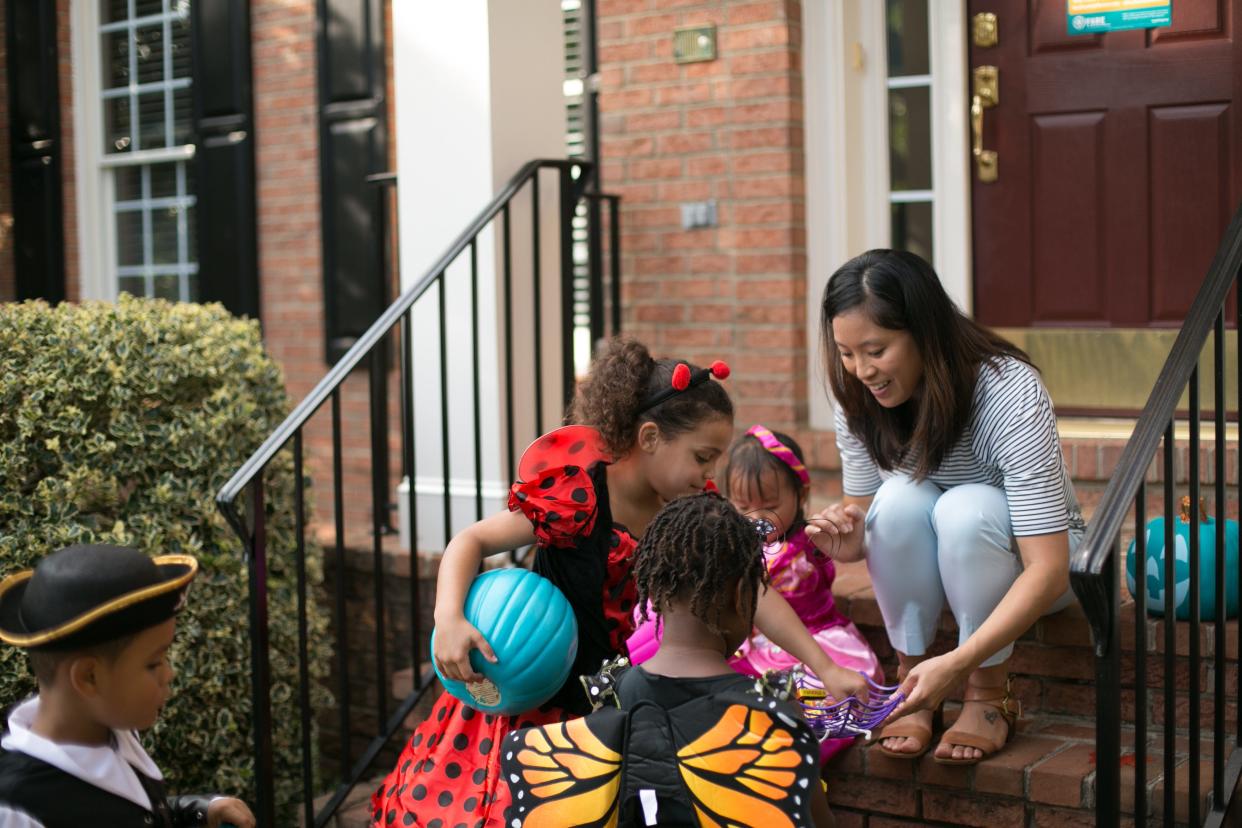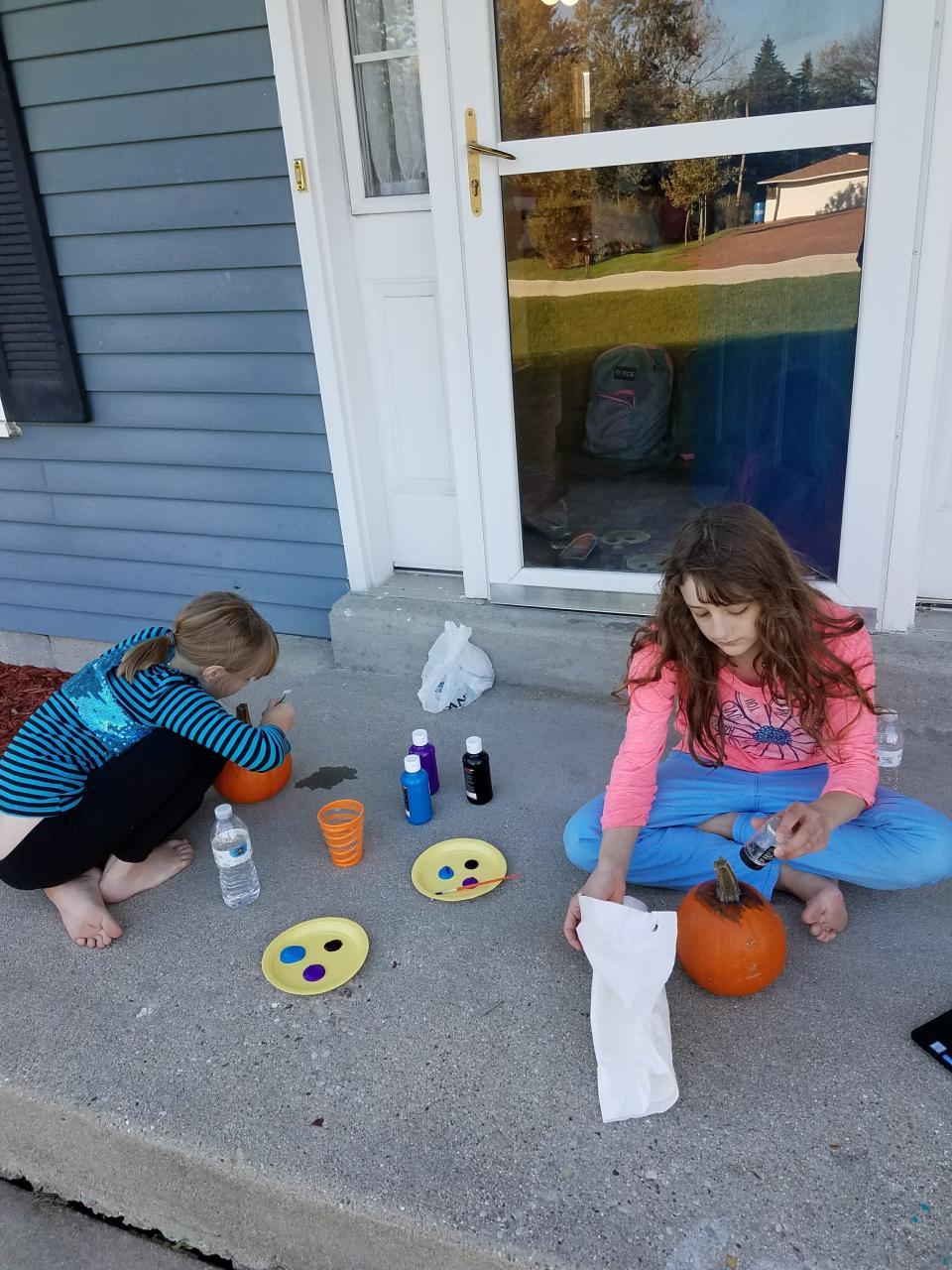It's hard for some kids with food allergies to get excited about trick-or-treat. The Teal Pumpkin Project can help.

My daughter, Alex, had an allergic reaction to peanut butter when she was 3. Her eye swelled shut and her skin broke out in head-to-toe hives. Luckily, because she was a picky toddler, playing with her food instead of eating it, her reaction wasn’t as bad as it could have been.
As we drove home from the hospital that night — after she was given steroids and Benadryl, and we were given a prescription for an EpiPen and an appointment with an allergist — my immediate thoughts were on clearing our house of everything with peanuts, wondering how to read food labels and how we would avoid future allergic reactions.
Eventually, as I got used to our new normal (which included severe allergies to both peanuts and eggs), my concerns turned to the things I was worried Alex wouldn’t be able to enjoy like a non-allergic child can — classroom birthday treats, impromptu weekend trips to bakeries and ice cream shops and all the food-centered celebrations that come with holidays.
Over the years, we’ve had wins. Like the restaurants we’ve found that are willing to specially make her favorite food — french fries — either by baking them or frying them separately from other foods.
And we’ve had losses. Like the times we’ve gone into candy stores with high hopes of finding a fun treat, only to discover that everything was cross-contaminated.
We’ve also had some embarrassing moments that are funny in hindsight. Here I’m remembering the Fourth of July when, as my family waited for the parade to start, I surreptitiously glanced at the bag of candy I saw sitting on one of the floats, hoping that when the parade started and the candy was thrown from the float, I could tell Alex it was safe for her to grab.
Apparently, I wasn’t as subtle as I thought I was because, as I reached out to move the bag so I could better read the label, I heard an “Excuse me” and turned around to see the driver of the float — who happened to be the mayor of our town — asking me what I was doing.
Everything turned out fine. After I stumbled over my words to explain myself, the mayor even offered to open up the (safe!) candy to give Alex a few pieces before the parade started. Even so, my face remained red for much of the parade.
More: Here are some not-so-scary Milwaukee area Halloween events
More: Here are 9 alternative trick-or-treat events happening in the Milwaukee area in 2022
Trick-or-treating when you can't eat the candy
When my daughter started school, she happened to join a class with several students with peanut allergies, and the moms of those kids quickly became my friend group. One thing we discussed was the most revered of kid-friendly holiday celebrations — trick-or-treat.
How does a kid have fun trick-or-treating when they can’t eat most of the candy? And it’s not just the stuff that’s obviously unsafe. Snickers bars, peanut butter cups and Butterfingers could be donated to a parent, friend or charity, but so many of the individually wrapped, fun-size candies that typically land in our kids’ plastic pumpkins don’t have ingredient labels on them. Although labeling laws require the most common food allergens to be listed, the bags of bulk candy people typically buy for trick-or-treat are often labeled on the main bag, but not on the candy the kids actually receive.

Throughout Alex’s childhood, we had to determine which things we could accommodate enough to allow her to enjoy them, and which things to simply bypass because the accommodations would take all the fun out of it.
Accommodating Halloween for food allergies
That line is different for all kids. For one of my friends, her child was most excited about dressing up and being out in the neighborhood with her cousins. That fun outweighed the fact that she had to give up much of her candy. For another friend, her child wasn’t even that interested in most of the treats and was fine with giving up his whole bucket of candy to his mom in exchange for some of his favorite snacks.

For Alex, the excitement of traipsing through the neighborhood in costume wasn’t enough to outweigh the fact that she would get her hopes up at each house, only to be disappointed more often than not to see something like a bag of M&Ms dropped in her bucket.
So our trick-or-treat tradition became this. My kids accompanied me to the store every year to buy big bags of their favorite, safe candy. During our city’s trick-or-treat hours, they dressed up in their costumes and stood excitedly by the door waiting to hand out candy to trick-or-treaters. I made sure to buy enough candy to allow them to steal their own treats from the stash whenever they wanted.
Also, on Halloween weekend, we would visit their grandparents’ houses where, in addition to plenty of candy they knew was safe, they would also be spoiled with Halloween-themed socks and lip gloss and coloring books, glow sticks and costume jewelry and — to this day, the thing Alex looks forward to most on Halloween — a giant, egg-free, frosting-covered sugar cookie baked by my mom.
I’m lucky that both of my kids are OK with our nontraditional trick-or-treating traditions. But, for kids who do want to go door-to-door throughout their neighborhoods, there are ways to be more inclusive.
The Teal Pumpkin Project
That’s where the Teal Pumpkin Project comes in. For the past 10 years, FARE (Food Allergy Research and Education) has been encouraging people to place a teal-painted pumpkin on their porch. The pumpkin indicates that, in addition to candy, you have a separate bowl of non-food trinkets and treats to hand out. FARE also has printable signs available on its website to hang on your window to explain what the teal pumpkin means. And, for the more high-tech route, you can add your address to the Teal Pumpkin Project map so families with food allergic kids know in advance to hit up your house on Halloween.
FARE suggests going to a Dollar store, party store or CVS to pick up some inexpensive trinkets. I’ve also had luck at Walgreens, Walmart and Target. Some of my favorite suggestions:
Small toys like mini Slinkies
Puzzles
Coloring books or activity books
Games like decks of cards or travel-sized board games
Halloween-themed pencils, notepads or erasers
Glow-in-the-dark toys like bracelets, necklaces or glow sticks
Creepy costume accessories like vampire fangs or spider rings
Bubbles
Stickers
Crayons or markers
Keep kids with food allergies in mind this Halloween
Alex is 18 now, and trick-or-treat isn’t a key part of our Halloween anymore (We’ve moved on to a Halloween night tradition of watching “Ghostbusters” and eating tacos). But I’m thankful for the people who made trick-or-treating a tradition she could enjoy rather than dread throughout her childhood.
For most kids with food allergies, it’s more than the possibility of an allergic reaction that makes their lives different from those of their friends. It’s what they have to give up in their day-to-day lives — the ability to enjoy food celebrations without thinking too much about it and without worrying about it, to be carefree as a child should be. But the kindness of people who are willing to learn, who are willing to accommodate – those are the things that help.
Contact Amy Schwabe at (262) 875-9488 or amy.schwabe@jrn.com. Follow her on Twitter at @WisFamilyJS, Instagram at @wisfamilyjs or Facebook at WisconsinFamily.
Our subscribers make this reporting possible. Please consider supporting local journalism by subscribing to the Journal Sentinel at jsonline.com/deal.
DOWNLOAD THE APP: Get the latest news, sports and more
This article originally appeared on Milwaukee Journal Sentinel: Teal Pumpkin Project helps kids with food allergies trick-or-treat

